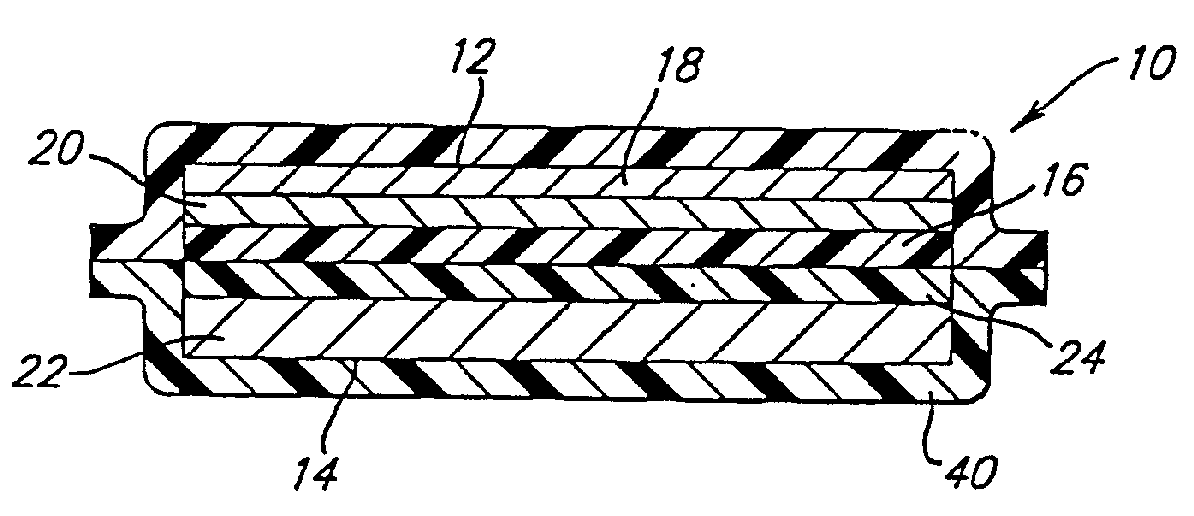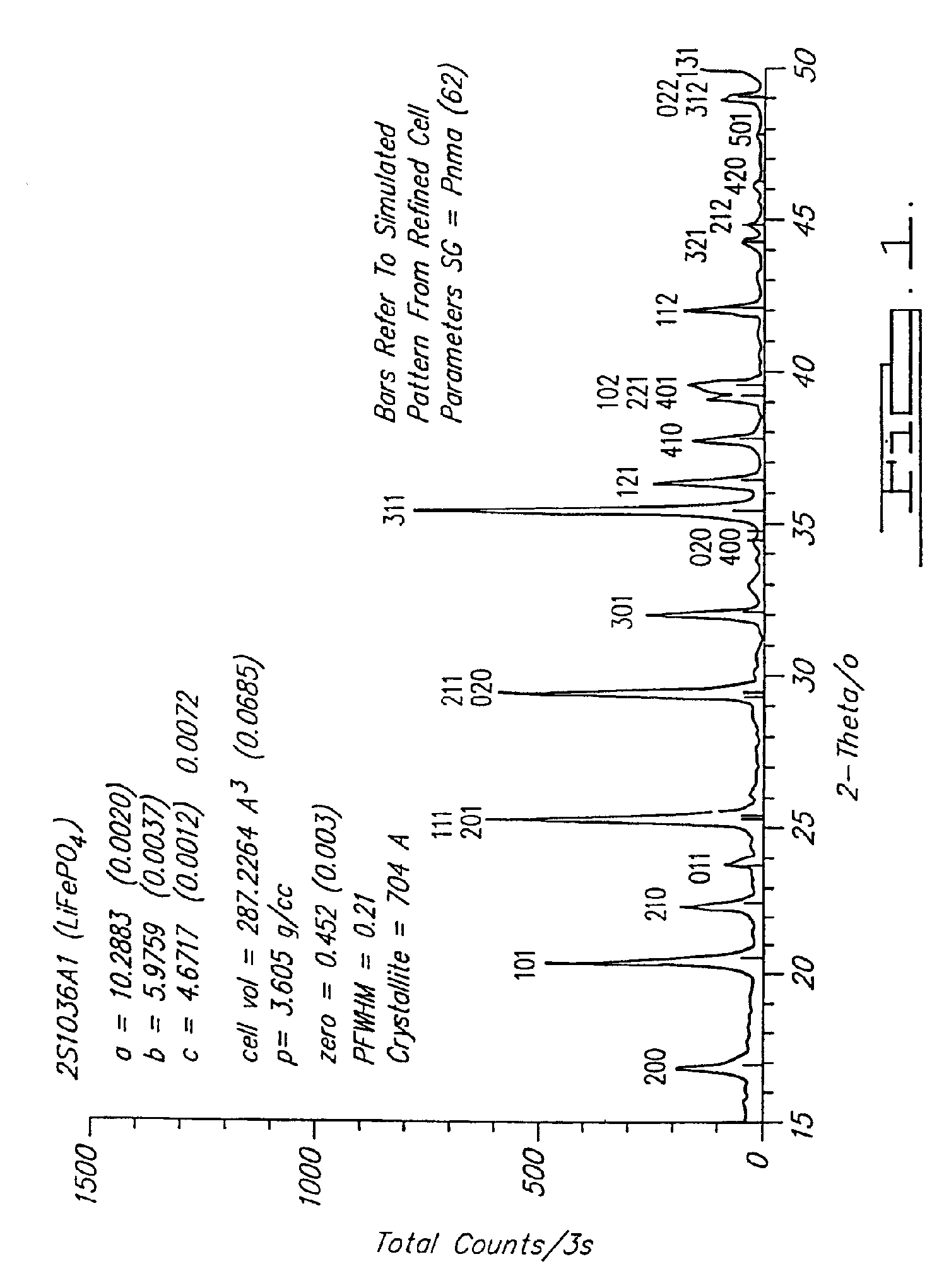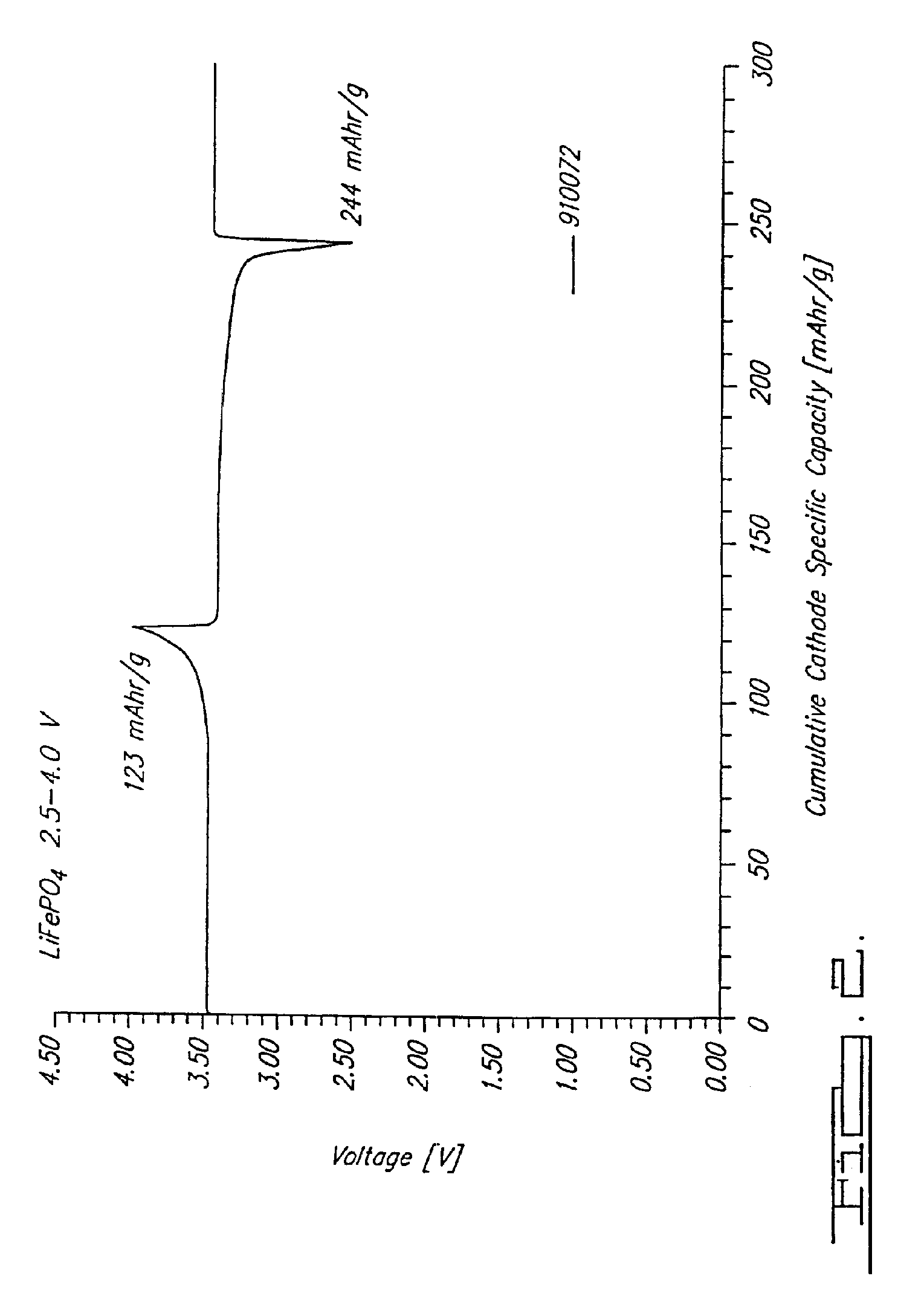Lithium-based active materials and preparation thereof
a technology of active materials and lithium-based materials, which is applied in the field of lithium-based active materials, can solve the problems of difficult to synthesize nickel compounds, low production efficiency, and low efficiency of nickel compounds, and achieves the effects of improving performance, improving capacity retention, and being readily adaptable to commercial production
- Summary
- Abstract
- Description
- Claims
- Application Information
AI Technical Summary
Benefits of technology
Problems solved by technology
Method used
Image
Examples
example i
Reaction 1(a). LiFePO4 Formed from FePO4
FePO4+0.5 Li2CO3+0.5 C →LiFePO4+0.5 CO2+0.5 CO
[0067] (a) Pre-mix reactants in the following proportions using ball mill. Thus,
1 mol FePO4150.82g0.5 mol Li2CO336.95g0.5 mol carbon6.0g
(but use 100% excess carbon → 12.00 g)
[0068] (b) Pelletize powder mixture
[0069] (c) Heat pellet to 750° C. at a rate of 2° / minute in flowing inert atmosphere (e.g. argon). Dwell for 8 hours at 750° C. under argon.
[0070] (d) Cool to room temperature at 2° / minute under argon.
[0071] (e) Powderize pellet. [0072] Note that at 750° C. this is predominantly a CO reaction. This reaction is able to be conducted at a temperature in a range of about 700° C. to about 950° C. in argon as shown, and also under other inert atmospheres such as nitrogen or vacuum.
example ii
Reaction 1(b). LiFePO4 Formed from Fe2O3
0.5 Fe2O3+0.5 Li2CO3+(NH4)2HPO4+0.5 C→LiFePO4+0.5 CO2+2 NH3+3 / 2 H2O+0.5 CO
[0073] (a) Premix powders in the following proportions
0.5 mol Fe2O379.85g0.5 mol Li2CO336.95g1 mol (NH4)2HPO4132.06g0.5 mol carbon6.00g
(use 100% excess carbon → 12.00 g)
[0074] (b) Pelletize powder mixture
[0075] (c) Heat pellet to 750° C. at a rate of 2° / minute in flowing inert atmosphere (e.g. argon). Dwell for 8 hours at 750° C. under argon.
[0076] (d) Cool to room temperature at 2° / minute under argon.
[0077] (e) Powderize
example iii
Reaction 1(c). LiFePO4—from Fe3(PO4)2
[0078] Two steps:
Part I. Carbothermal Preparation of Fe3(PO4)2
3 / 2Fe2O3+2(NH4)2HPO4+3 / 2 C→Fe3(PO4)2+3 / 2 CO+4NH3+5 / 2 H2O
[0079] (a) Premix reactants in the following proportions
3 / 2 mol Fe2O3239.54g2 mol (NH4)2 HPO4 264.12g3 / 2 mol carbon18.00g
(use 100% excess carbon → 36.00 g)
[0080] (b) Pelletize powder mixture
[0081] (c) Heat pellet to 800° C. at a rate of 2° / minute in flowing inert atmosphere (e.g. argon). Dwell for 8 hours at 750° C. under argon.
[0082] (d) Cool to room temperature at 2° C. / minute under argon.
[0083] (e) Powderize pellet.
Part II. Preparation of LiFePO4 from the Fe3(PO4)2 of Part I.
Li3PO4+Fe(PO4)2→3 LiFePO4
[0084] (a) Premix reactants in the following proportions
1 mol Li3PO4115.79 g1 mol Fe3(PO4)2357.48 g
[0085] (b) Pelletize powder mixture
[0086] (c) Heat pellet to 750° C. at a rate of 2° / minute in flowing inert atmosphere (e.g. argon). Dwell for 8 hours at 750° C. under argon.
[0087] (d) Cool to room temperature at 2...
PUM
| Property | Measurement | Unit |
|---|---|---|
| melting point | aaaaa | aaaaa |
| reaction temperatures | aaaaa | aaaaa |
| reaction temperatures | aaaaa | aaaaa |
Abstract
Description
Claims
Application Information
 Login to View More
Login to View More - R&D
- Intellectual Property
- Life Sciences
- Materials
- Tech Scout
- Unparalleled Data Quality
- Higher Quality Content
- 60% Fewer Hallucinations
Browse by: Latest US Patents, China's latest patents, Technical Efficacy Thesaurus, Application Domain, Technology Topic, Popular Technical Reports.
© 2025 PatSnap. All rights reserved.Legal|Privacy policy|Modern Slavery Act Transparency Statement|Sitemap|About US| Contact US: help@patsnap.com



